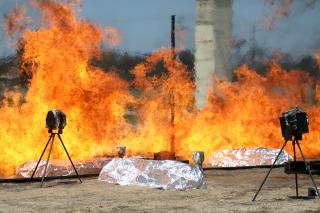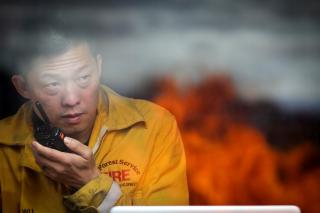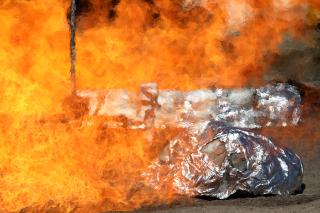Forest Service Turns Up the Heat for Safety
By Andrew Avitt, May 30, 2023-
For wildland firefighters, knowing their equipment and gear are tested and proven to handle the stresses and rigors of wildland fire operations should never be in question. When they’re headed for the heat, wildland firefighters need to know that the gear they’re bringing with them can take the stress.
That’s why the USDA Forest Service’s National Technology and Development Program works hard to ensure the highest quality equipment makes it to the fire line. Gloves, harnesses, backpacks, fire engines, water tenders, water pumps, hoses, fire shelters, and communication and tracking devices — all on a long list of gear vetted by engineers and specialists at these centers.
In early May, technicians with the National Technology and Development Program booted up their flame front simulator at Vandenburg Space Force Base to do just that.
“The flame front simulator allows us to create and simulate a wildfire, to adjust the intensity and change the behavior of how that fire acts. Essentially the system acts like a smart barbecue grill,” said Sam Wu, a project manager at the National Technology and Development Center in San Dimas, California.
The flame front simulator is controlled through a computer, which opens and closes fuel lines and ignites the burners in the simulator.

The propane-charged simulator is a maze of fuel lines, piping and burners, within a space that is 47 feet by 25 feet. This machine creates fire behavior similar to what firefighters might see on a landscape. Sensors throughout the simulator allow the team to measure air temperatures, heat flux, and how much heat is transferred to the test equipment.
“The simulator is designed so that we can mimic wildfire conditions. Temperatures at the high end can reach over 1800 degrees Fahrenheit,” said Wu.
Fine tuning the settings to reflect how actual wildfire behaves will better inform equipment testing in the future. The team collected a variety of data: how fuel flowed through the burners, how long the simulator took to fully ignite, and how closely the simulator reflected different types of wildfire, including timber, sage brush and tall grass.
Testing firefighting gear with real fire is not a new idea. However, the old way, which involved starting a small fire on a real plot of wildland, had too many drawbacks. These experiments are unsuitable during hotter dryer months when wildfire activity is at its highest. Also, the older method made data analysis less certain. The variables can be difficult to control, such as wind, vegetation, and how wet or dry the brush or timber may be.
“With the simulator, we have consistent fuel that we are burning,” said Wu. “We know exactly how much propane is being burned and have a good idea of what kind of fire it would represent and the total amount of heat that’s being produced.”
This also allows the team from the Technology and Development Program to repeat more tests.

“With the simulator, we’re dealing with much more controlled variables,” said Wu. “We can sequence various rows of burners and set it to allow the flames to progress in a certain fashion.”
During the simulated burn, the team ran tests on fire shelters, a fire- resistant tent-like product that all wildland firefighters carry while on duty. In circumstances when they cannot escape advancing flames, firefighters are trained to ditch their gear, pull out their fire shelter, and climb inside as the flame front passes.
The testing team assessed the temperatures around and inside the fire shelters, examining the amount of fire exposure that begins to break down the materials. This data can make all the difference in protecting firefighters on the line.
“We’re looking to tell a holistic story around what’s happening when flames interact with a fire shelter,” said Wu. “But those results aren’t just useful when it comes to current fire shelters. This data will also be used to develop tests for the burns that we’ll be doing in the future to yield more realistic simulated burns, to test the wildland firefighting gear of tomorrow.”
For more photos of the flame front simulator and the technicians with the Technology & Development Center in action, visit: Flame Front Simulator | Flickr.
